Disclosure: Meeple Mountain received a free copy of this product in exchange for an honest, unbiased review. This review is not intended to be an endorsement.
Surely you’ve had an encounter with a sliding puzzle at least once in your life — perhaps you received one as a child in a loot bag from a classmate’s birthday party or maybe your first was a prize in a cereal box. My earliest memory of a sliding puzzle featured a beauty shot of a brown horse on white tiles surrounded by a neon green border. I found the puzzle so incredibly frustrating to solve that I eventually gave up, removed every tile from its bordering frame, pieced together the puzzle, and then snapped the tiles back into the frame in the correct orientation. (This is the sliding puzzle equivalent of solving a Rubik’s cube by rearranging its stickers.)
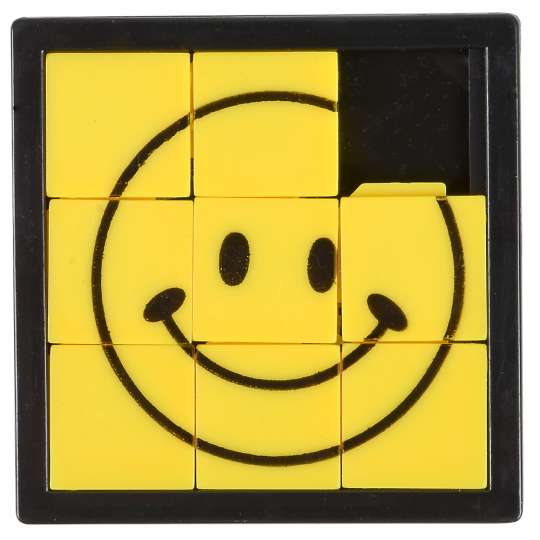
When I was asked to review Flash 8, a competitive game based on the sliding puzzle’s design, I was a little reluctant, but the appeal of the game’s speed element eventually lured me in. Was it enough to counteract my earlier negative experience with sliding puzzles? Continue reading to find out.
Flash 8 Gameplay
Flash 8 is a competitive speed puzzle game for one to four players in which you control electrons that zip through the city…although this is the only bit of thematic flavour you’ll be getting in this review (mostly because the theme doesn’t come through in the gameplay itself, unless you consider electrons move quickly as theme).
Each player has their own tablet (game board) and a set of eight electrons (three blue, two yellow, and one each of red, green, and purple). The goal of Flash 8 is to score the most points, which is done by arranging electrons on your tablet to match the electron configurations shown on the faceup cards (similar to the pattern matching in Kanoodle Head-to-Head).
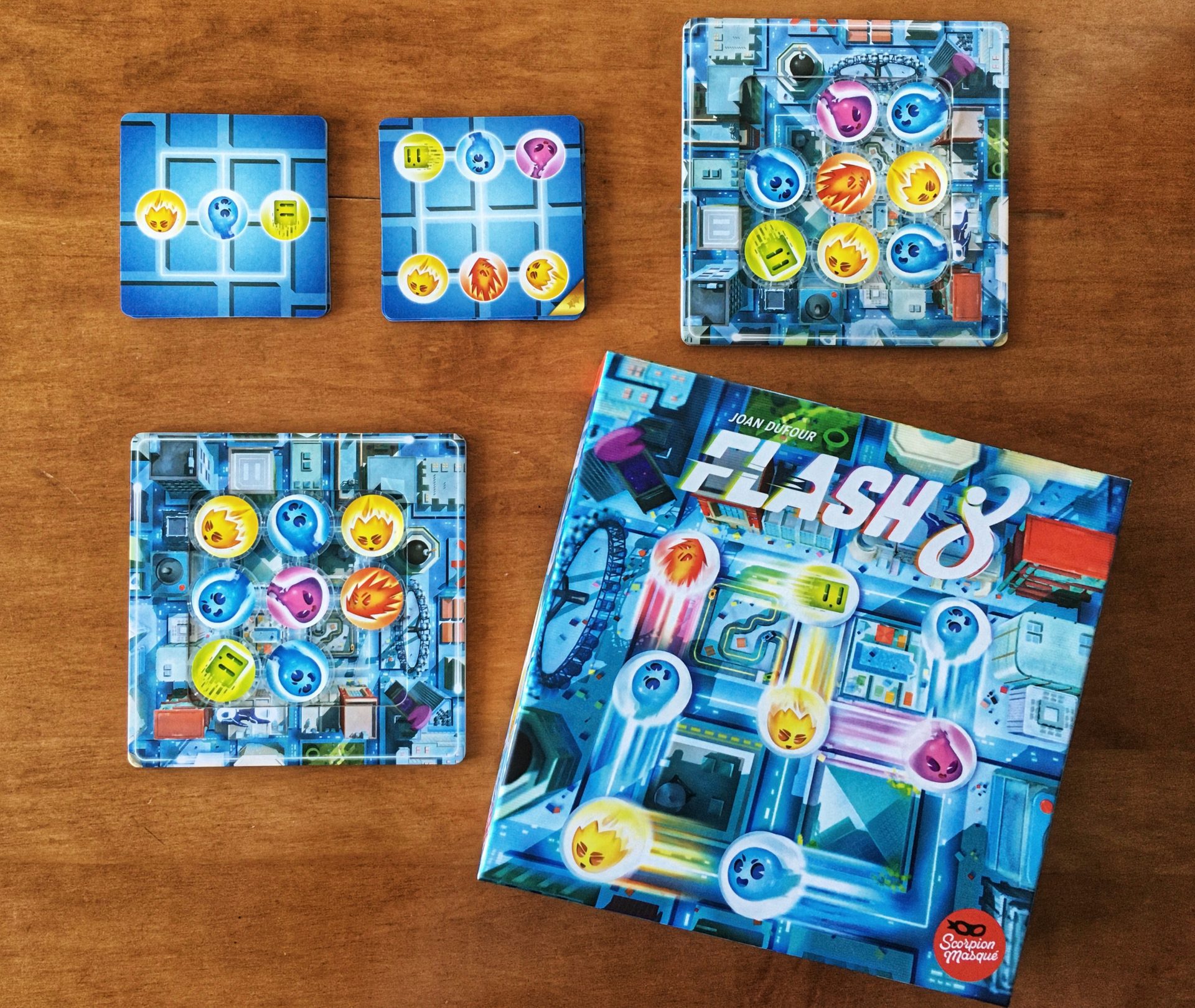
In Flash 8 there are no turns; everyone plays simultaneously trying to recreate the visible electron configurations, which is done by sliding the electrons into the empty space on your tablet with a single finger — don’t worry the electrons are grooved and large enough for big fingers. Players are free to choose any visible card to work towards, but they must recreate it based on their perspective of the card. This means that even if every player tried to replicate the same card, the arrangement would look different on every tablet.
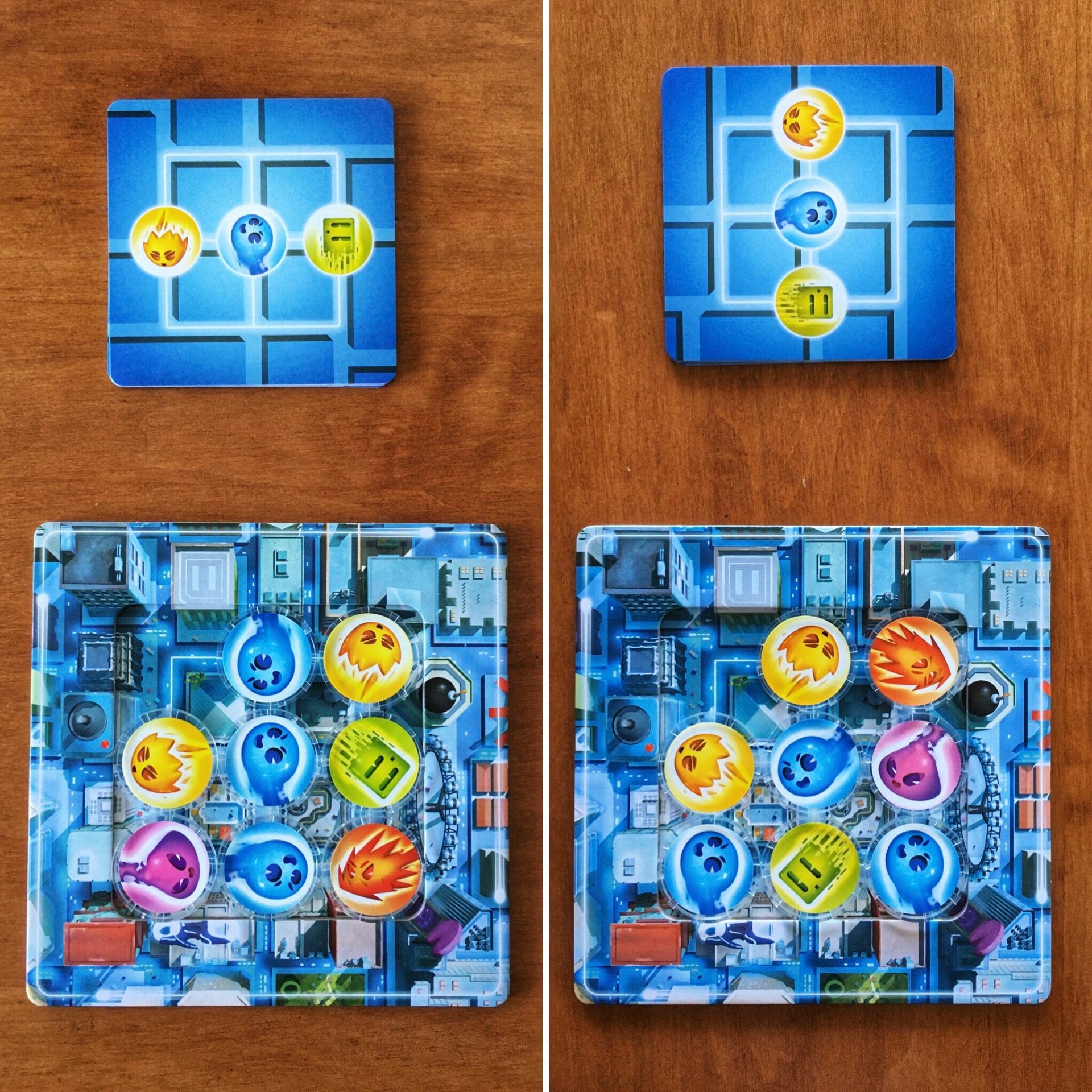
Once a player perfectly reproduces one of the cards, they say, “Flash!” and play stops. This player shows the others their work — without rotating their tablet or the card. Then they take the card to score at the end of the game, revealing a new card in the stack, and resuming play immediately.
When there are no cards left on the table, the game ends and players count their points: one point for each card they reproduced, unless it depicts two stars in the corner (these are worth two points). The player with the most points wins.
Flash 8’s gameplay is as simple as that. There are two different gameplay variants included so let’s take a look at both.
Flash 8 Variants
Making the Game Easier
Just like those sliding puzzles, Flash 8 can be quite a difficult game to play, especially given the speed element. Luckily there’s a way to make it easier, which might be needed for younger gamers. During setup, remove one blue electron from any player who needs this accommodation. This creates two empty spaces on their tablet instead of one.
Solo Mode
The solo mode for Flash 8 keeps the essence of the multiplayer game, but there are a few changes and a four-minute timer (not included) is added to the game. To begin, the cards are used on their “solo” side and nine cards are laid out in a 3×3 grid. The remaining cards are placed in a stack, known as the “reserve.”
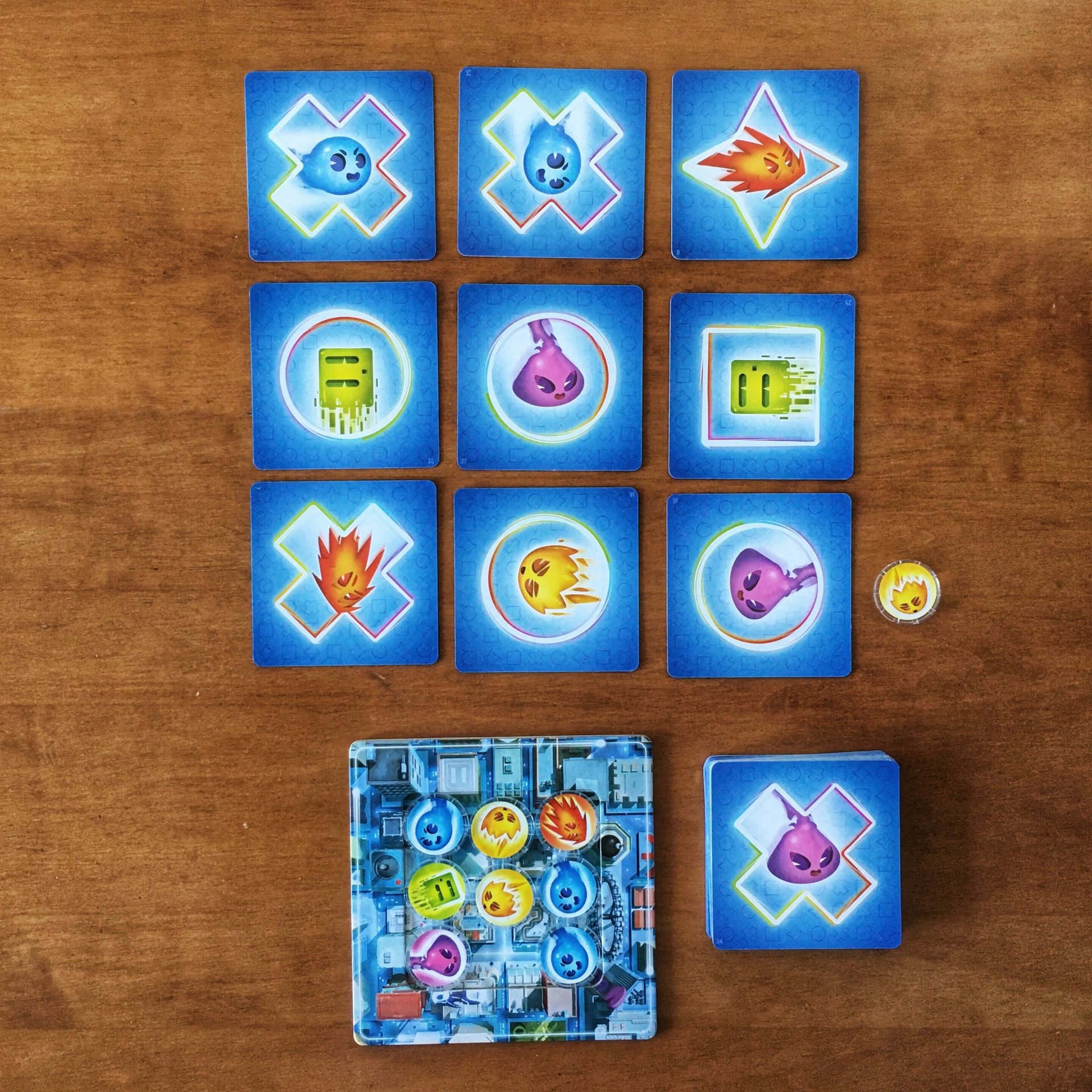
In the solo game, you’re trying to replicate an electron configuration of a row or column from the 3×3 grid, based on your perspective (just like the multiplayer game).
When you’ve successfully reproduced a line, choose a shape — circle, cross, star, or square — and use the cards from the reserve stack to cover all the cards showing this shape in the line you just reproduced.
Additionally, place the reminder token (an unused electron) next to the line you replicated. This prevents you from reproducing an electron configuration in the same position twice in a row.
The solo game ends when the four-minute timer is up or when you can’t reproduce a line in the grid. Then count the number of cards remaining in the reserve and compare it to the table in the rulebook.
Final Thoughts
There is nothing as humbling as playing a game in a genre you both enjoy and think you excel in (speed puzzle games) and struggling through every second of it. That is how I feel every time I play Flash 8. I’m transported back to the moment I first tried to solve that darn horse sliding puzzle and all I want to do is cheat to make everything easier…but I can’t cheat. The tablet is recessed so the electrons sit nice and cozy within it, with no chance of “accidentally” escaping off the edge of the tablet, but — more importantly — no one likes a cheater and I couldn’t bring myself to be that kind of gamer, even if it would temporarily make me feel a little better.
And yet, even though Flash 8 kicks me in the pants every single time, I still want to play it.
I’ve reviewed a number of speed puzzle games for Meeple Mountain (Tuki, Ubongo!, Dimension) and while they are all challenging in their own way, their difficulty doesn’t compare to Flash 8 — for me at least. What differentiates Flash 8 is the way it works the sliding puzzle into a competitive game. A few years ago, Mesozooic tried this and while it worked quite well, much of the gameplay focused on card drafting and optimizing your points whereas Flash 8 just focuses on the puzzle solving.
Flash 8 is also unique in that the game’s state is open and dynamic; players can work towards solving any of the visible cards. Can’t get the red electron to go where you want it? Forget it and try another card. Struggling to reproduce any of the visible configurations? Maybe you’ll get lucky and be close to solving a new revealed card. It is this freedom and flexibility that keep me coming back to Flash 8’s multiplayer game. I can take a minute (or two) to work out a card’s configuration while my opponents try other cards and when I finally solve it I might know I won’t win the game, but I still feel a sense of accomplishment.
Flash 8’s solo mode is a whole other beast because it adds an extra layer of puzzling to the game (the symbols), introduces a timer, and forces you to manage your electrons to ensure you never have too many cards in the grid with the rarer electrons (red, purple, and green). Flash 8’s solo mode is my favourite of the solo-able speed puzzle games I reviewed because it truly poses a challenge for solo gamers.
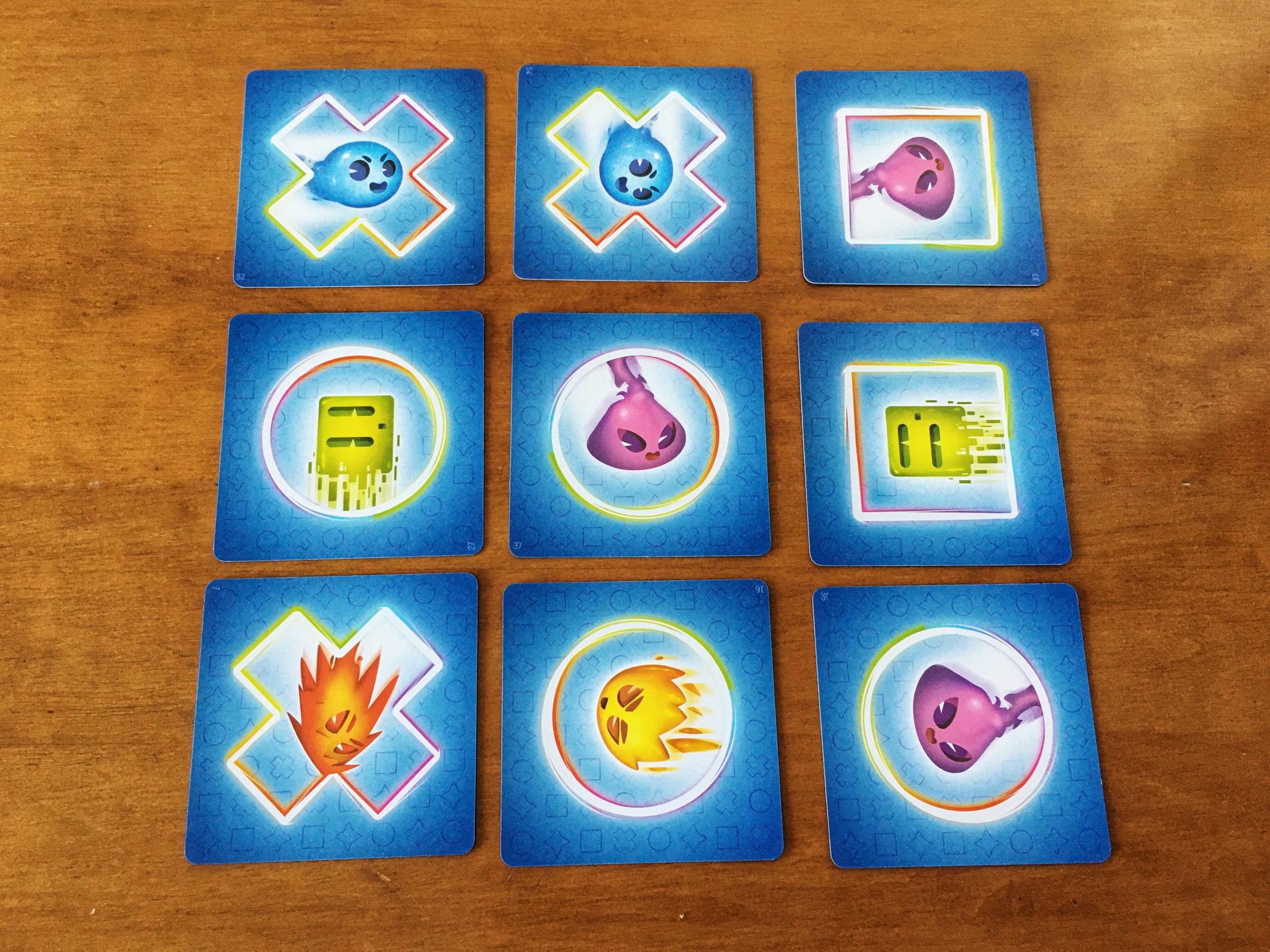
As for Flash 8’s other variant, the simplified modification, it’s amazing how just removing one electron can completely change the gameplay and give you a much needed confidence boost…er I mean help younger gamers play with their adult counterparts on a more even playing field.
Flash 8 is a hit for me, even though it can sometimes make me feel pretty inept. I still appreciate its design and gameplay — both solitaire and multiplayer — and I especially appreciate its challenge.
I love that publisher Le Scorpion Masqué is doing their part to help the planet: since July 2010 they have partnered with Tree Canada to replace the trees used to make their games.


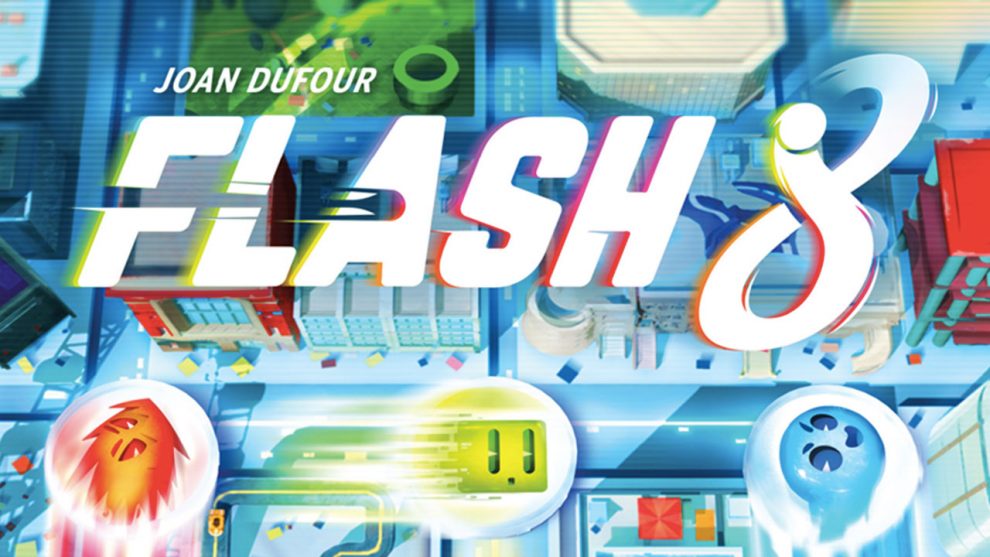
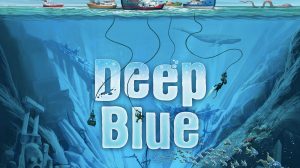







I have always loved sliding puzzles. This looks like fun!